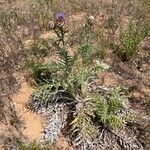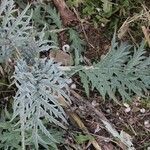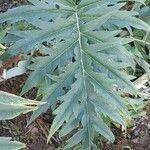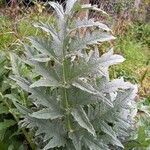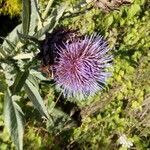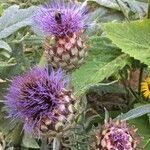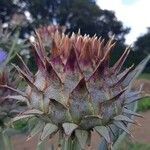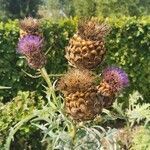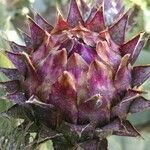Taproots fleshy. Stems glabrous to densely arachnoid-tomentose. Leaves: basal blades 30–200 cm, margins deeply 1–2-pinnately lobed or divided to nearly compound, lobes oblong to lanceolate, entire to coarsely toothed, teeth and lobes innocuous to prominently spine-tipped, spines 1–30 mm, often clustered along petiole and at base of lobes, abaxial faces densely gray-or white-tomentose, adaxial faces thinly cobwebby-tomentose; cauline leaves often short-decurrent as spiny wings. Involucres often purplish tinged, 30–150 × 40–150 mm excluding spreading phyllary tips, constricted distally or not. Phyllaries lanceolate to broadly ovate, bases appressed, spreading apices obtuse to acute or acuminate, spineless or tipped with spines 1–9 mm or truncate, abruptly mucronate, and spineless or minutely spine-tipped. Corollas blue or purple (rarely white), 3–5 cm; styles long-exserted. Cypselae 4–8 mm; pappus bristles 2–4 cm.
A perennial herb. It grows 1.5-1.8 m high and 1.2-1.5 m across. It has a fleshy taproot. The leaves are large and silvery green. They are woolly and white underneath. They are divided into narrow primary and secondary lobes. The secondary lobes end in a harsh spine. The flowers are thistle flower heads. They can be 8 cm across. The base of the flower head is prickly and the top is purple. There are several cultivated varieties.
It is a perennial herb to 2 m high with leaves to 80 cm long and 40 cm wide. Large capitula (6–8 cm) with purple florets
See subsp. flavescens
